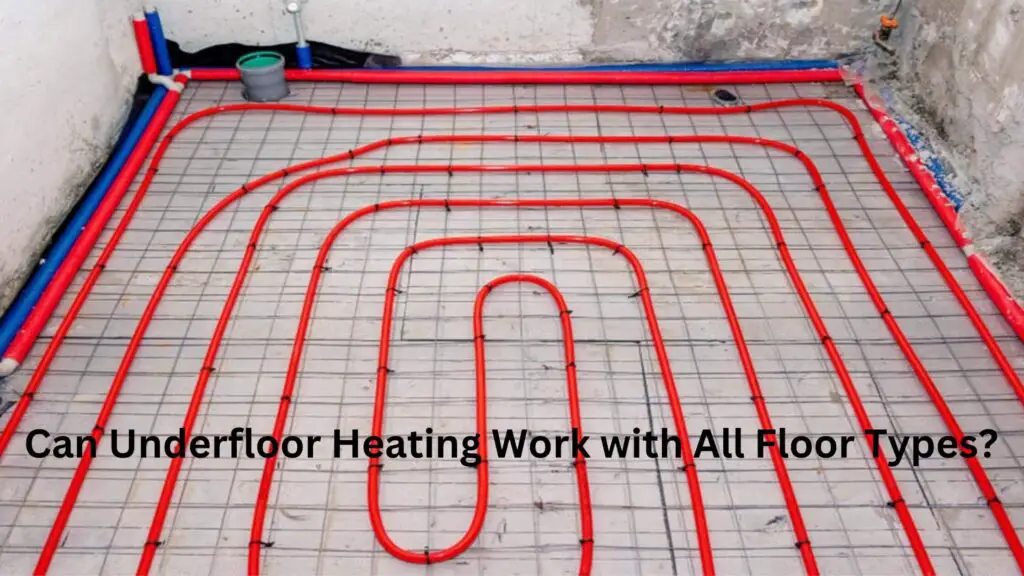Can underfloor heating work with all floor types? A common question for many homeowners wondering if the system can work with carpets, tiles, wood, or other floors. Learn the answers now.
Exploring underfloor heating is more than just about adding warmth; it’s about understanding which floorings will increase or lessen efficiency. In this article, we will explore the best floorings for underfloor heating, from engineered wood to polished screed, vinyl and tiled, as we take a deep dive into what type of flooring you can use with underfloor heating.
Key points:
- Evaluate eco-friendly attributes of underfloor heating systems.
- Identify floor types that are less suitable for underfloor heating.
- Tips on preparing your floor for efficient underfloor heating installation.
- Insights into the waiting period before activating underfloor heating.
- Overview of various flooring options like laminate, vinyl, and carpet suitable for underfloor heating.
Is Underfloor Heating Eco-Friendly?
Underfloor heating is an innovative solution towards eco-friendly heating.
Water underfloor heating kits stand out as particularly eco-friendly options. These systems utilise water heated to a moderate 35-45 degrees Celsius, significantly lower than traditional radiators. This efficiency is amplified when paired with renewable energy sources like heat pumps, potentially improving energy efficiency by up to 60%. Such systems demonstrate why underfloor heating is not only a practical choice but a conscientious one, aligning with eco-friendly standards by reducing energy consumption.
Suitable and Unsuitable Flooring Types
What type of flooring can you use with underfloor heating?
The answer varies based on the material’s ability to conduct heat. Flooring materials are generally categorised into insulators and conductors. Conductive materials like stone, tiles, and concrete excel with underfloor heating due to their ability to swiftly and evenly distribute heat.
On the other hand, insulative materials such as carpet and wood might pose challenges. While these materials can still be used with underfloor heating, they do not transfer heat as efficiently, potentially leading to slower heat distribution and retention.
Certain types of wood, particularly solid wood flooring, are notably problematic with underfloor heating. The intense heat can cause solid wood to dry, shrink, and subsequently create gaps. When the system cools down, the wood absorbs moisture and expands, risking damage and distortion to the flooring structure.
Installation Tips
To maximise the effectiveness of flooring with underfloor heating, precise and expert installation is crucial. Here are some guidelines to ensure your underfloor heating system functions flawlessly:
- Even Heat Distribution: Avoid hotspots by ensuring the heat spreads evenly across the floor.
- Secure Flooring: Lay the floor close to the subfloor without gaps to prevent drying and uneven heating.
- Manage Humidity: Maintain the room’s relative humidity under 60% during and after installation to avoid moisture-related issues.
- Choose Suitable Underlays: Opt for underlays with low thermal resistance and integrated Damp Proof Membranes (DPM) to improve the system’s efficiency and protect against moisture.
Preparing the Floor for Underfloor Heating
Preparing the foundation for underfloor heating is important for ensuring long lasting benefits of the system. Whether you’re retrofitting or installing in new builds, the preparation phase can significantly impact the overall performance and health of your flooring. Here are essential steps to prepare your floor for underfloor heating:
- Thorough Cleaning: Begin by thoroughly cleaning the area using only the best materials. This ensures that no debris interferes with the installation process.
- Insulation Installation: Lay down insulation boards, making sure to seal all joints and gaps precisely. This step is vital for minimising heat loss.
- Sand Application: In areas that will experience regular foot traffic, fill under the boards with sand for added stability and insulation.
- Membranes: For liquid screed applications, use a 500-1000 gauge membrane. Ensure it’s laid out smoothly without creases and tape it to the perimeter walls to create a vapour barrier.
- Piping Accommodation: Create openings for any heating pipes, sealing around them with expanding foam to prevent air leaks and potential thermal bridging.
Best Flooring Options
Now that you are aware of what standards should be met before you begin laying your underfloor heating, here are our recommendations for the best flooring types to ensure your underfloor heating can perform at its best.
1. Laminate Flooring with Underfloor Heating
Laminate flooring is a popular choice for those looking to combine aesthetics with functionality. It’s well-suited for underfloor heating because of its durability and resistance to warping under temperature changes, whether it’s small or drastic. When selecting laminate, always verify that it’s rated as “suitable for use with underfloor heating.”
Follow installation guidelines carefully to ensure optimal heat distribution and prevent any potential issues.
2. Luxury Vinyl Flooring (LVT)
Luxury Vinyl Tile (LVT) stands out for its robustness and flexibility, making it an excellent candidate for underfloor heating systems. LVT adjusts well to temperature changes, reducing the risk of damage over time.
Always check for compatibility with underfloor heating before purchase. Be sure to follow the specific underfloor heating guidelines so that it can work seamlessly alongside the LVT.
3. Engineered Wood Flooring
Engineered wood flooring offers the beauty of wood without the drawbacks when paired with underfloor heating.
Engineered wood is designed to handle temperature variations, making it more stable than solid wood under such conditions.
Choose a flooring with a thickness of around 15mm to allow efficient heat transfer. Check product specifications to ensure the wood is compatible with underfloor heating systems.
4. Carpet Flooring
Carpet can also be paired effectively with underfloor heating, especially when using systems designed for such integration, like foil heaters.
These systems feature a thin, multi-strand, dual-core heating cable enclosed by a fibre-reinforced foil, promoting even heat distribution without significantly raising floor levels. This setup not only ensures a warm floor but also contributes to a healthier indoor environment by minimising air circulation that can spread dust and allergens.
Key Benefits
- Air Quality: Carpet traps dust and allergens, which are not stirred up by the gentle heat rising from underfloor systems.
- Comfort: Provides a soft, warm surface that aids the comfort provided by the heating system.
5. Polished Screed
Polished screed offers an appealing blend of durability and modern aesthetics, making it a preferred choice for both commercial and residential settings. This type of flooring aligns well with underfloor heating systems due to its excellent thermal conductivity, making it better than traditional flooring materials like hardwood and carpet.
The thickness of polished screed can vary from 0.15 mm to 6 mm, depending on its use. Thicker applications are typically used in commercial environments to withstand heavier foot traffic, whereas thinner layers are common in homes.
For renovations, incorporating a glass fibre rendering mesh with the screed can prevent stress fractures.
In new constructions, the underfloor heating system can be seamlessly integrated into the screed subfloor without additional modifications.
6. Rubber Flooring
Rubber flooring, often seen in high-impact areas like gyms and workshops, presents unique challenges when paired with underfloor heating. While durable and safe, rubber is not an ideal conductor of heat, but is still a potential option.
Rubber can emit a noticeable chemical smell when heated, which may be problematic for those with sensitivities or allergies.
Additionally, rubber’s insulative properties mean it does not effectively transfer heat, which can be a significant drawback in underfloor heating applications.
Rubber also has a tendency to expand and contract with temperature changes that can lead to structural issues over time. These characteristics suggest that while rubber flooring might be suitable for specific uses, it may not be the best candidate for underfloor heating systems.
When To Turn On Underfloor Heating
Understanding when to activate underfloor heating after installation will ensure that it has no issues alongside your flooring type.
Generally, it is advisable to wait about one week before fully activating the underfloor heating system. This period allows the flooring to acclimate and settle properly.
To avoid any potential damage, start at a lower temperature setting and gradually increase it each day. This method helps to ensure that the flooring adjusts slowly to the changes in heat, reducing the risk of warping or other issues.
In summary, underfloor heating can indeed work with all floor types, both to a greater or to a lesser extent. In this article we have highlighted which flooring options are best for underfloor heating. However, by considering factors such as thermal conductivity of polished screed to the careful considerations required for rubber flooring, each material offers unique benefits and challenges. By preparing the floor properly, understanding material specifics, and correctly timing the activation of underfloor heating, you can ensure a seamless integration and create a cosy, comfortable environment in your home.
FAQs
Is it cheaper to leave underfloor heating on all the time?
No, it is not cheaper to leave underfloor heating on constantly. It is more cost-effective to use a programmable thermostat to control the heating based on occupancy and usage patterns.
Are all floor tiles suitable for underfloor heating?
Not all floor tiles are suitable for underfloor heating. Tiles with good thermal conductivity, such as ceramic or porcelain, are best as they effectively transfer heat. It’s important to check the tile specifications for compatibility with underfloor heating systems.
Does underfloor heating add value to a house?
Yes, underfloor heating can add value to a house. It is a desirable feature for many homebuyers due to its efficiency and the comfort it provides, potentially increasing the property’s marketability and sale price.
Sources
Screwfix. (2024) Damp Proofing. [online] Available at: https://www.screwfix.com/c/building-doors/membranes-barriers/cat850236 [accessed 13/09/24]

